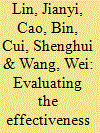| Srl | Item |
| 1 |
ID:
098594


|
|
|
|
|
| Publication |
2010.
|
| Summary/Abstract |
To assess the effectiveness of urban energy conservation and GHG mitigation measures, a detailed Long-range Energy Alternatives Planning (LEAP) model is developed and applied to analyze the future trends of energy demand and GHG emissions in Xiamen city. Two scenarios have been designed to describe the future energy strategies in relation to the development of Xiamen city. The 'Business as Usual' scenario assumes that the government will do nothing to influence the long-term trends of urban energy demand. An 'Integrated' scenario, on the other hand, is generated to assess the cumulative impact of a series of available reduction measures: clean energy substitution, industrial energy conservation, combined heat and power generation, energy conservation in building, motor vehicle control, and new and renewable energy development and utilization. The reduction potentials in energy consumption and GHG emissions are estimated for a time span of 2007-2020 under these different scenarios. The calculation results in Xiamen show that the clean energy substitution measure is the most effective in terms of energy saving and GHG emissions mitigation, while the industrial sector has the largest abatement potential.
|
|
|
|
|
|
|
|
|
|
|
|
|
|
|
|
| 2 |
ID:
122730


|
|
|
|
|
| Publication |
2013.
|
| Summary/Abstract |
For more holistic inventory estimation, this paper uses a hybrid approach to access the carbon footprint of Xiamen City in 2009. Besides carbon emissions from the end-use sector activities (called Scope 1+2 by WRI/WBCSD) in normal research, carbon emissions from the cross-boundary traffic and the embodied energy of key urban imported materials (namely Scope 3) were also included. The results are as follow: (1) Carbon emissions within Scope 1+2 only take up 66.14% of total carbon footprint, while emissions within Scope 3 which have usually been ignored account for 33.84%. (2) Industry is the most carbon-intensive end use sector which contributes 32.74% of the total carbon footprint and 55.13% of energy use emissions in Scope 1+2. (3) The per capita carbon footprint of Xiamen is just about one-third of that in Denver. (4) Comparing with Denver, the proportion of embodied emissions in Xiamen was 10.60% higher than Denver. Overall, Xiamen is relatively a low-carbon city with characters of industrial carbon-intensive and high embodied emissions. Further analysis indicates that the urbanization and industrialization in Xiamen might cause more material consumption and industrial emissions. These highlight the importance of management for Scope 3 emissions in the developing cities.
|
|
|
|
|
|
|
|
|
|
|
|
|
|
|
|